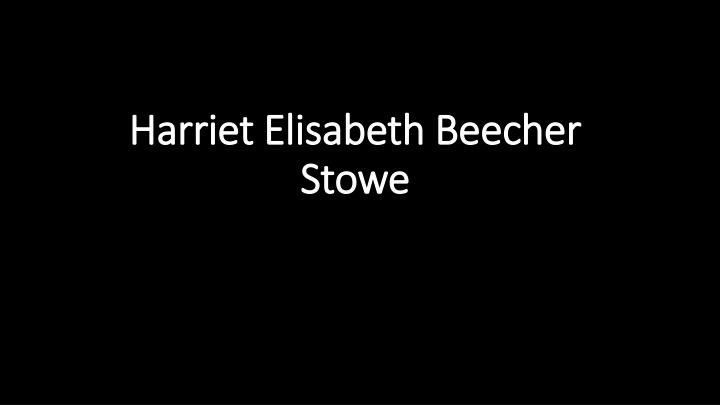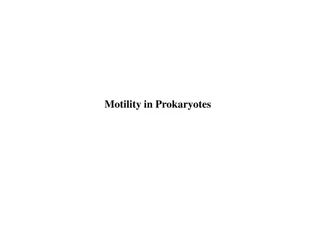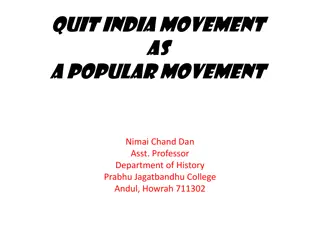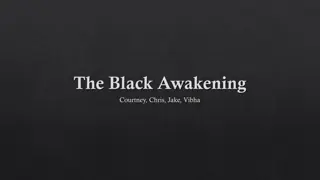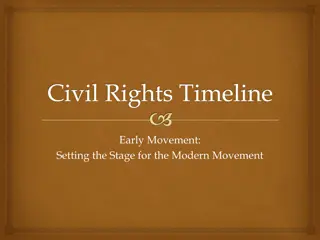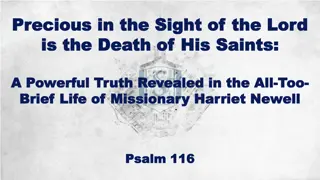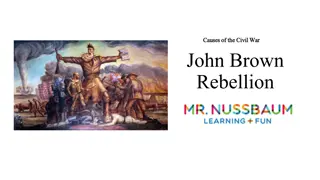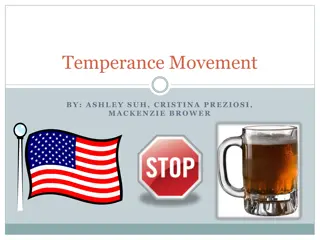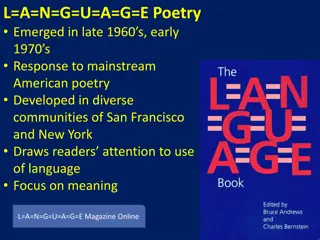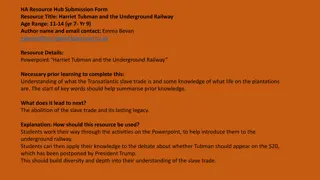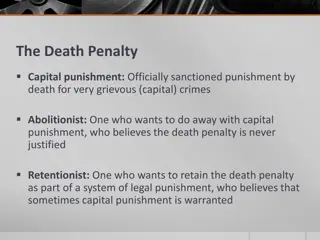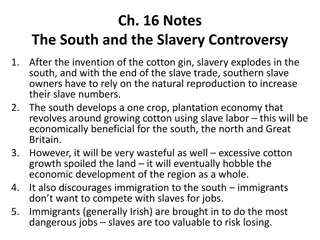Harriet Elisabeth Beecher Stowe and the Abolitionist Movement
Harriet Elisabeth Beecher Stowe, known for her influential novel "Uncle Tom's Cabin," was an American abolitionist from the renowned Beecher family. She highlighted the harsh conditions of enslaved African Americans. The Fugitive Slave Act of 1850 and the American Civil War played significant roles in the abolitionist movement. Stowe's work shed light on the dehumanizing effects of slavery, portraying various aspects of this inhumane practice.
Download Presentation

Please find below an Image/Link to download the presentation.
The content on the website is provided AS IS for your information and personal use only. It may not be sold, licensed, or shared on other websites without obtaining consent from the author.If you encounter any issues during the download, it is possible that the publisher has removed the file from their server.
You are allowed to download the files provided on this website for personal or commercial use, subject to the condition that they are used lawfully. All files are the property of their respective owners.
The content on the website is provided AS IS for your information and personal use only. It may not be sold, licensed, or shared on other websites without obtaining consent from the author.
E N D
Presentation Transcript
Harriet Elisabeth Beecher Harriet Elisabeth Beecher Stowe Stowe
Harriet Elisabeth Beecher Stowe (1811 1896) was an American abolitionist and author. She came from the Beecher family, a famous religious family, and is best known for her novel Uncle Tom's Cabin (1852), which depicts the harsh conditions for enslaved African Americans.
The Fugitive Slave Act or Fugitive Slave Law was passed by the United States Congress on September 18, 1850,as part of the Compromise of 1850 between Southern slave-holding interests and Northern Free-Soilers The Act was one of the most controversial elements of the 1850 compromise and heightened Northern fears of a "slave power conspiracy". It required that all escaped slaves, upon capture, be returned to their masters and that officials and citizens of free states had to cooperate. In the early stages of the American Civil War, the Union had no established policy on escaping slaves. Many slaves escaped from plantations to Union lines, but in the early stages of the war, runaway slaves were often returned by Union forces to their masters
Abolitionism Abolitionism Abolitionism (or the Anti-Slavery Movement) in the United States of America was the movement which sought to end slavery in the United States, active both before and during the American Civil War. In the Americas and western Europe, abolitionism was a movement which sought to end the Atlantic slave trade and set slaves free.
American Civil War The American Civil War (also known by other names) was a civil war fought in the United States from 1861 to 1865, between the North (the Union) and the South (the Confederacy). The Civil War began primarily as a result of the long-standing controversy over the enslavement of black people. War broke out in April 1861 when secessionist, separatist, forces attacked Fort Sumter in South Carolina shortly after Abraham Lincoln had been inaugurated as the President of the United States.
Slavery and Race Slavery and Race Harriet Beecher Stowe wrote Uncle Tom's Cabin in order to demonstrate the living dramatic reality of slavery. The novel protests the horrors of this institution: the way it degrades black men and women and gives absolute power to slaveowners and thereby corrupts them. The novel portrays and explores various kinds of slavery. The Shelbys treat Uncle Tom and other slaves as part of a separate, childlike addition to the family. Augustine St. Clare allows his slaves the run of the household, understands the evil of the institution, but feels he cannot stop it until it s too late. Simon Legree, the cruelest of all of the slave masters depicted, works his slaves as hard as possible, dominating them so fully that he often kills them. Miss Ophelia, who does not own slaves and represents Northern anti-slavery abolitionist views, has trouble even touching the black girl Topsy, whom she tutors. Through these various depictions, Beecher Stowe argues that all forms of slavery, benevolent charitable or not, lead to immorality among blacks and whites, and an unchristian life, and further points out that slavery is a complex system, involving Northern business interests as well as Southern ownership. At the same time, Stowe's conception of race can feel out of sync with contemporary values, and, at its worst, racist itself. In particular, Uncle Tom's love of his masters has been interpreted, by some, as a misplaced loyalty to a dominant white culture. An understanding of slavery in Uncle Tom's Cabin requires at least some separation of the author's anti-slavery message from the attitudes and language of her time and place. But it is certainly not incorrect to argue that while Beecher Stowe was strongly anti-slavery she did not in fact believe that the races were created equal.
Christianity and Christian Charity Christianity and Christian Charity Uncle Tom's Cabin repeatedly references the Bible, especially the New Testament. The dominant morality of the United States is, according to Beecher Stowe, a Christian one, and slavery is utterly incompatible with it. Uncle Tom owns only one book the Bible and is often found reading it, slowly and with great religious feeling. He quotes the Bible to educate Eva, Cassy, and others, and to find the strength to survive his own trials. The Quakers who help George, Eliza, and Harry escape and who take in Tom Loker despite his aggression toward them justify their actions not as generosity to black people but as a duty to God and man, demanded of them by the Bible. Miss Ophelia embodies a colder, more distant Northern Christianity, which values the lives of slaves but is unwilling to help them personally. But as the novel continues, it becomes clear that the Golden Rule is the paramount Christian law: humans ought to treat one another as they themselves wish to be treated. Uncle Tom serves as a Christ-figure or martyr in the novel. Tom dies protecting Cassy and Emmeline and will not whip his fellow slaves; he suffers so that others might live. Eva demonstrates a kind of saintliness: she behaves in strict accordance with Jesus' teachings, and her death is an example to her father, causing him to regain his faith (however briefly before he is killed). Ultimately, Beecher Stowe argues through the novel that a more truly Christian system of values in the United States would eradicate slavery altogether and render Uncle Tom's and Eva s sacrifices unnecessary.
Women Women Uncle Tom's Cabin contains numerous strong female characters. The social role and importance of women, both white and black, is emphasized throughout the novel, and female characters are often linked by interaction and influence. Eva is fair-skinned and beautiful, generous, deeply religious, and always kind; she becomes an example to the uneducated, heathenish Topsy. After Eva's death, Topsy grows (with Miss Ophelia's help) into a Christian woman. Miss Ophelia herself believes in duty as a manifestation of love and Christian charity; she finds slavery hateful but must learn, through Topsy, to actually interact with blacks. Marie St. Clare, on the other hand, is forgiving, lazy, quick to blame others, and her Christianity is merely performance. Mammy, Eva's favorite servant, serves as a counterpoint to both she is stormy and committed to helping the St. Clare family. Back in Kentucky, Eliza and Mrs. Shelby are paired: both are caring mothers, and when Eliza flees to protect her child, Mrs. Shelby distracts those pursuing her. Cassy and Emmeline also form a kind of mother-daughter relationship as they escape to Canada together, and are eventually reunited with their blood relatives. Beecher Stowe strongly implies that women are more affected by the horrors of slavery than are men. Black women see their children taken away and can themselves be sold into sexual bondage. White women understand these problems because they have children of their own. Indeed, it is difficult to read the inspiring language of equality and freedom in the novel without applying it to the rights of all women in society, black and white. Many of Stowe s arguments about equality before God, the necessities of nonviolence and Christian love might be extended to a discussion of the place of women in America, where white women also did not at the time have the right to vote.
Home Home Uncle Tom's cabin, described early in the novel, represents the warmth and love of family life. It is a place Tom hearkens back to over the course of his trials. George Shelby wishes to bring Tom home, and at the close of the book, he points to Tom's cabin as a symbol of honest work and Christian faith. Other homes are juxtaposed with the cabin. The Shelby estate is genteel and placid, though disrupted upon the sale of Tom and Harry. The St. Clare mansion is filled with color, wonderfully decorated, an island of comfort surrounded by the horrors of Louisiana plantation country. The Legree estate is dilapidated and used only to make money eventually it is haunted by ghosts. Legree loves no one, and his destroyed home makes evident this lack of love. George, Eliza, and Harry's new home is, ironically, a place where they might live out the American ideals of life, liberty, and the pursuit of happiness, but it is located in Montreal. Home also takes on another dimension in the novel: that of a heavenly home after death, in God's abode. Eva claims she is going home when she is dying, and slaves who feel they have no home on earth may take comfort in the next life. In heaven the human family is reunited; even though black and white people may not live together in harmony on earth, a Christian belief in the afterlife will guarantee equality and peace.
Freedom Freedom is a central and complex concept in Uncle Tom's Cabin. Slaves wish to be free, and abolitionists in the novel wish also to free the slaves. But, as St. Clare points out, what is to be done after the abolition of slavery? Is it enough simply to release the slaves, to let them do as they wish? George Harris argues for the colonization of Liberia by freed slaves. Many thought this a viable option before and after the Civil War. George Shelby eventually frees his father's slaves but allows them to live and work on the family estate for a wage, with the ability to choose to leave. This is an improvement over slavery, but it looks quite a bit like slavery or serfdom, as was the case with sharecropping in the South after the Civil War. Beecher Stowe also asks whether freedom might be possible while still under the yoke of slavery. Some despairing slaves, like Cassy, believe at first that slavery has taken their souls, their humanity. But Uncle Tom declares that his soul will always remain free, that Legree can do nothing to destroy it. In this sense, Tom remains the master of himself. Conversely, the author implies that slavery can make slaves of its masters. St. Clare believes slavery degrades everyone though he is mostly powerless to stop it; his wife claims her slaves are a plague, even as she thinks she cannot live without them. To Beecher Stowe, freedom is not an on-off switch between Free and Enslaved. The goal of society is human betterment the creation of a more Christian country and in achieving such a country, Beecher Stowe believes, more people will gain the ability to direct their own lives, to live with charity and goodness, to work according to their inclination, and to raise their own families. This deepens freedom for all. But these improvements are possible only in a country itself freed from the scourge of slavery.
